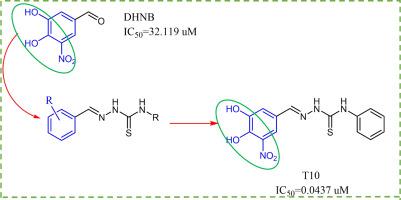当前位置:
X-MOL 学术
›
Eur. J. Pharm. Sci.
›
论文详情
Our official English website, www.x-mol.net, welcomes your
feedback! (Note: you will need to create a separate account there.)
A potential therapeutic agent for the treatment of hyperuricemia and gout: 3,4-Dihydroxy-5-nitrobenzaldehyde phenylthiosemicarbazide
European Journal of Pharmaceutical Sciences ( IF 4.3 ) Pub Date : 2024-04-21 , DOI: 10.1016/j.ejps.2024.106778 Xiongying Yu 1 , Shuaiwei Ren 2 , Jun Zhou 1 , Yongcui Liao 1 , Yousheng Huang 2 , Huanhuan Dong 2
European Journal of Pharmaceutical Sciences ( IF 4.3 ) Pub Date : 2024-04-21 , DOI: 10.1016/j.ejps.2024.106778 Xiongying Yu 1 , Shuaiwei Ren 2 , Jun Zhou 1 , Yongcui Liao 1 , Yousheng Huang 2 , Huanhuan Dong 2
Affiliation

|
Uric acid, the metabolic product of purines, relies on xanthine oxidase (XOD) for production. XOD is a target for the development of drugs for hyperuricemia (HUA) and gout. Currently, treatment options remain limited for gout patients. 3, 4-Dihydroxy-5-nitrobenzaldehyde (DHNB) is a derivative of the natural product protocatechualdehyde with good biological activity. In this work, we identify a DHNB thiosemicarbazide class of compounds that targets XOD. 3,4-Dihydroxy-5-nitrobenzaldehyde phenylthiosemicarbazone can effectively inhibit XOD activity (IC50 value: 0.0437 μM) and exhibits a mixed inhibitory effect. In a mouse model of acute hyperuricemia, a moderate dose (10 mg/kg.w) of 3,4-dihydroxy-5-nitrobenzaldehyde phenylthiosemicarbazide effectively controlled the serum uric acid content and significantly inhibited serum XOD activity. In addition, 3,4-Dihydroxy-5-nitrobenzaldehyde phenylthiosemicarbazide showed favorable safety profiles, and mice treated with the target compound did not show any symptoms of general toxicity following a single dose of 500 mg/kg. In the allopurinol group, 50 % of the mice died. These results provide a structural framework and mechanism of XOD inhibition that may facilitate the design of hyperuricemia and gout treatments.
中文翻译:

治疗高尿酸血症和痛风的潜在治疗剂:3,4-二羟基-5-硝基苯甲醛苯硫脲
尿酸是嘌呤的代谢产物,依赖黄嘌呤氧化酶(XOD)产生。 XOD是开发治疗高尿酸血症(HUA)和痛风药物的靶标。目前,痛风患者的治疗选择仍然有限。 3, 4-二羟基-5-硝基苯甲醛(DHNB)是天然产物原儿茶醛的衍生物,具有良好的生物活性。在这项工作中,我们鉴定了一种针对 XOD 的 DHNB 氨基硫脲类化合物。 3,4-Di羟基-5-硝基苯甲醛苯硫缩氨基脲可有效抑制XOD活性(IC50值:0.0437 μM),并表现出混合抑制作用。在急性高尿酸血症小鼠模型中,中等剂量(10 mg/kg.w)3,4-二羟基-5-硝基苯甲醛氨基硫脲可有效控制血清尿酸含量,并显着抑制血清XOD活性。此外,3,4-二羟基-5-硝基苯甲醛苯硫脲显示出良好的安全性,用目标化合物治疗的小鼠在单剂量 500 mg/kg 后没有表现出任何一般毒性症状。在别嘌呤醇组中,50% 的小鼠死亡。这些结果提供了 XOD 抑制的结构框架和机制,可能有助于高尿酸血症和痛风治疗的设计。
更新日期:2024-04-21
中文翻译:

治疗高尿酸血症和痛风的潜在治疗剂:3,4-二羟基-5-硝基苯甲醛苯硫脲
尿酸是嘌呤的代谢产物,依赖黄嘌呤氧化酶(XOD)产生。 XOD是开发治疗高尿酸血症(HUA)和痛风药物的靶标。目前,痛风患者的治疗选择仍然有限。 3, 4-二羟基-5-硝基苯甲醛(DHNB)是天然产物原儿茶醛的衍生物,具有良好的生物活性。在这项工作中,我们鉴定了一种针对 XOD 的 DHNB 氨基硫脲类化合物。 3,4-Di羟基-5-硝基苯甲醛苯硫缩氨基脲可有效抑制XOD活性(IC50值:0.0437 μM),并表现出混合抑制作用。在急性高尿酸血症小鼠模型中,中等剂量(10 mg/kg.w)3,4-二羟基-5-硝基苯甲醛氨基硫脲可有效控制血清尿酸含量,并显着抑制血清XOD活性。此外,3,4-二羟基-5-硝基苯甲醛苯硫脲显示出良好的安全性,用目标化合物治疗的小鼠在单剂量 500 mg/kg 后没有表现出任何一般毒性症状。在别嘌呤醇组中,50% 的小鼠死亡。这些结果提供了 XOD 抑制的结构框架和机制,可能有助于高尿酸血症和痛风治疗的设计。






























 京公网安备 11010802027423号
京公网安备 11010802027423号